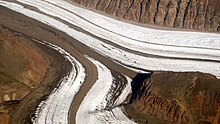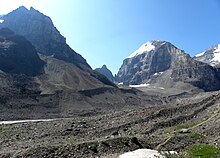Types of moraines
See also: List of glacial moraines
Moraines can be classified either by origin, location with respect to a glacier or former glacier, or by shape. The first approach is suitable for moraines associated with contemporary glaciers—but more difficult to apply to old moraines, which are defined by their particular morphology, since their origin is debated. Some moraine types are known only from ancient glaciers, while medial moraines of valley glaciers are poorly preserved and difficult to distinguish after the retreat or melting of the glacier.
Lateral moraines
Lateral moraines are parallel ridges of debris deposited along the sides of a glacier. The unconsolidated debris can be deposited on top of the glacier by frost shattering of the valley walls and/or from tributary streams flowing into the valley. The till is carried along the glacial margin until the glacier melts. Because lateral moraines are deposited on top of the glacier, they do not experience the postglacial erosion of the valley floor and therefore, as the glacier melts, lateral moraines are usually preserved as high ridges.

Moraines clearly seen on a side glacier of the Gorner Glacier, Zermatt, Switzerland. The lateral moraine is the high snow-free bank of debris in the top left hand quarter of the picture. The medial moraine is the double line of debris running down the centre-line of the glacier.
Lateral moraines stand high because they protect the ice under them from the elements, causing it to melt or sublimeless than the uncovered parts of the glacier. Multiple lateral moraines may develop as the glacier advances and retreats.
Ground moraines
Ground moraines are till-covered areas with irregular topography and no ridges, often forming gently rolling hills or plains. They are accumulated at the base of the ice as lodgment till, but may also be deposited as the glacier retreats. In alpine glaciers, ground moraines are often found between the two lateral moraines. Ground moraines may be modified into drumlins by the overriding ice.
Rogen moraines
Main article: Rogen moraine
Rogen moraines or ribbed moraines are a type of basal moraines that form a series of ribs perpendicular to the ice flow in an ice sheet. The depressions between the ribs are sometimes filled with water, making the Rogen moraines look like tigerstripes on aerial photographs. Rogen moraines are named after Lake Rogen[6] in Härjedalen, Sweden, the landform’s type locality.

Medial moraines, Nuussuaq Peninsula, Greenland
End or terminal moraines
Main article: Terminal moraine
End moraines, or terminal moraines, are ridges of unconsolidated debris deposited at the snout or end of the glacier. They usually reflect the shape of the glacier's terminus. Glaciers act much like a conveyor belt, carrying debris from the top of the glacier to the bottom where it deposits it in end moraines. End moraine size and shape are determined by whether the glacier is advancing, receding or at equilibrium. The longer the terminus of the glacier stays in one place, the more debris accumulate in the moraine. There are two types of end moraines: terminal and recessional. Terminal moraines mark the maximum advance of the glacier. Recessional moraines are small ridges left as a glacier pauses during its retreat. After a glacier retreats, the end moraine may be destroyed by postglacial erosion.
Recessional moraine
Recessional moraines are often observed as a series of transverse ridges running across a valley behind a terminal moraine. They form perpendicular to the lateral moraines that they reside between and are composed of unconsolidated debris deposited by the glacier. They are created during temporary halts in a glacier's retreat.[2][7]
Medial moraine
A medial moraine is a ridge of moraine that runs down the center of a valley floor. It forms when two glaciers meet and the debris on the edges of the adjacent valley sides join and are carried on top of the enlarged glacier. As the glacier melts or retreats, the debris is deposited and a ridge down the middle of the valley floor is created. The Kaskawulsh Glacier in the Kluane National Park, Yukon, has a ridge of medial moraine 1 km wide.
The prominent dark streak at the left quarter is forming a medial moraine.
This is seen as a mudflat at the water's surface. (Brüggen Glacier, Patagonia)
This is seen as a mudflat at the water's surface. (Brüggen Glacier, Patagonia)
Supraglacial moraines
Supraglacial moraines are created by debris accumulated on top of glacial ice. This debris can accumulate due to ice flow toward the surface in the ablation zone, melting of surface ice or from debris that falls onto the glacier from valley sidewalls.
Washboard moraines
Washboard moraines, also known as minor or corrugated moraines, are low-amplitude geomorphic features caused by glaciers. The name "washboard moraine" refers to the fact that, from the air, it resembles a washboard.
Veiki moraine
Main article: Veiki moraine




No comments:
Post a Comment